Thank you for Subscribing to Construction Business Review Weekly Brief
Specials
- Apartment and Condominium Contractors Canada
- Decking Canada
- Architectural Glass Europe
- MEP APAC
- Construction Saudi Arabia
- German Apartment and Condominium Contractors
- Construction Law APAC
- Outdoor Construction
- Foundation Construction Canada
- MEP Canada
- Kitchen and Bath
- Cold Storage Construction APAC
- Precast Concrete Europe
- Construction Staffing Europe
- Pre-Construction Services
- Flooring System APAC
- Scaffolding Canada
- Swimming Pool Construction Canada
- Construction Management Canada
- Cold Storage Construction Canada
- Flooring Systems Europe
- Residential Construction
- Concrete Canada
- Construction Cladding Europe
- Construction Cladding APAC
- Concretes, Aggregates and Construction Materials APAC
- Concretes, Aggregates and Construction Materials Europe
- Commercial Contractors Europe
- Commercial Contractors APAC
- Dummy
- Construction Insulation, Coating and Waterproofing
- Construction Management APAC
- Landscaping Canada
- Construction Coating Europe
- Construction Tech Startups Europe
- Insulation Services Europe
- Mechanical Contractor Canada
- Mould Remediation and Testing Europe
- Swimming Pool Construction APAC
- Building Sealing Solutions Europe
- Construction Engineering Services
- Mechanical Electrical and Plumbing
- Roofing Systems Europe
- Architectural Glass APAC
- Startups APAC
- Construction Forensic and Owners Representative
- Flooring System
- Waterproofing APAC
- Wall Systems
- Safety and Compliance Europe
- Construction Bidding and Auctions
- Modular and Prefab Construction
- Architectural Glass
- Construction MENA
- Construction Demolition and Recycling Europe
- Modular Construction Europe
- Construction Interiors
- Steel Building APAC
- HVAC
- Doors and windows
- Construction Latam
- Building Information Modeling APAC
- Sustainable Construction APAC
- Building Restoration and Maintenance
- Commercial Contractors
- Specialty Construction
- Construction Engineering Canada
- Construction Engineering MENA
- Modular Construction Canada
- Modular Construction APAC
- Roofing and Siding Systems
- Workforce Management and Staffing
- Roofing Systems APAC
- Construction Consulting
- Steel Building Europe
- Construction Demolition and Recycling APAC
- Safety and Compliance APAC
- Concretes, Aggregates and Construction Materials
- Construction Cladding
Shaping the Future of Structural Engineering
Structural engineering will evolve with advancements in technology, sustainability, and resilience, enhancing efficiency and eco-friendliness to support a sustainable future worldwide.

By
Construction Business Review | Tuesday, February 18, 2025
Stay ahead of the industry with exclusive feature stories on the top companies, expert insights and the latest news delivered straight to your inbox. Subscribe today.
Structural engineering will evolve with advancements in technology, sustainability, and resilience, enhancing efficiency and eco-friendliness to support a sustainable future worldwide.
Fremont, CA: Structural engineering is evolving in response to societal demands, technological advancements, and increasing sustainability concerns. Emerging trends are reshaping this critical field, enhancing efficiency and safety in construction, addressing environmental challenges, and transforming urban landscapes.
The introduction of Building Information Modeling is changing structural engineering through digitalized representation of physical structures, improving collaboration among engineers, architects, and contractors. Instead, It will facilitate workflow's easy flow, minimize errors, and allow sound communication among stakeholders. When BIM advances further, it might include real-time data analysis and predictive modeling features. This can make engineers predict challenges in advance and optimize designs more proactively.
Sustainability is the other driver for structural engineers shortly. Growing awareness of climate change and everything associated with construction operations is compelling engineers to develop environmentally friendly buildings and infrastructure with a minimal carbon footprint. Sustainable materials include recycled steel and low-carbon concrete and innovative construction techniques such as modular construction, which can reduce waste and energy consumption. For instance, green building certifications such as LEED and BREEAM are gaining popularity, making incorporating greener practices into projects compulsory.
Another momentum is building in the acceptance of innovative technologies in structural engineering. The Internet of Things, through embedding sensors and monitoring systems into structures, can provide real-time data gathering on structural integrity, temperature, and even the presence of occupants.





